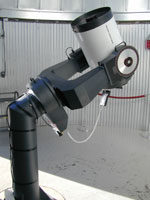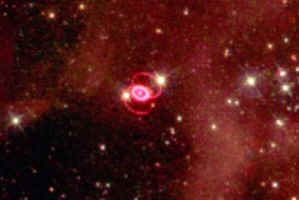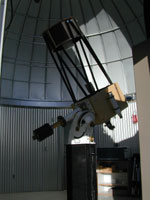|
How
do we know dark matter exists?
Dark matter is
the name scientists have given to the particles
which we believe exist in the Universe, but
which we cannot directly see! Dark matter was
initially called "missing matter"
because astronomers could not find it by
observing the Universe in any part of the
electromagnetic spectrum. This material appears
to have mass (and therefore generates gravity),
but it does not appear to absorb or emit any
electromagnetic radiation. Given the fact that
it does not send us any light (which is how we
have learned most of what we know about the
Universe), it is not difficult to understand
that it has been hard to discover anything about
the nature of these mysterious particles. But do
not despair, scientists are coming up with
clever new ways to probe the dark parts of the
cosmos!
Scientists
study dark matter by looking at the effects it
has on visible objects. Scientists believe that
dark matter may account for the unexplained
motions of stars within galaxies. Computers play
an important role in the search for dark matter
information. They allow scientists to create
models which predict galaxy behavior. Satellites
are also being used to gather dark matter
information. In 1997, a Hubble Space Telescope
image revealed light from a distant galaxy
cluster being bent by another cluster in the
foreground of the image. Based on the way the
light was bent, scientists estimated the mass of
the foreground cluster to be 250 times greater
than the visible matter in the cluster.
Scientists believe that dark matter in the
cluster accounts for the unexplained mass.
More recently,
astronomers have used NASA's Chandra X-ray
Observatory to make the most detaile measurement
yet of the distribution of dark matter in a
massive cluster of galaxies. Chandra observed a
cluster of galaxies called Abell 2029 located
about a billion light-years from Earth. The
cluster is composed of thousands of galaxies
enveloped in a gigantic cloud of hot gas, and an
amount of dark matter equivalent to more than a
hundred trillion Suns! The hot gas in the
cluster is held in the cluster primarily by the
gravity of the dark matter, so the distribution
of the hot gas is determined by that of the dark
matter. By precisely measuring the distribution
of X-rays from the hot gas, the astronomers were
able to make the best measurement yet of the
distribution of dark matter near the center of a
galaxy cluster. Extrapolating from their
results, their results indicate that about 80
percent of the total amount of matter in the
Universe consists of a form of dark matter
called "cold dark matter" - to
distinguish it from "hot dark matter".
Cold? Hot? These terms do to refer to the
temperature of the particles, but to the speed
at which the dark matter particles were moving
when the galaxies began to form billions of
years ago. According to computer models, there
are two possibilities for how dark matter would
have been behaving at that time depending on
exactly how and when it formed. Cold dark matter
would have been moving slowly by the time of
galaxy formation; hot dark matter would still
have been moving quickly.
|

|
|
This
composite image (Chandra X-ray image on
the left and DSS optical image on the
right) of the galaxy cluster Abell 2029
shows a huge hot gas cloud (as seen in
X-rays) envelopes the galaxies in the
cluster (the bright spots in the visible
image). The cluster does not behave as
scientists would expect it to if only the
visible matter is generating the gravity
present in the cluster. 'Dark matter'
theory suggests that a huge amount of dark
(invisible to direct observation) matter,
interacting gravitationally with the
normal, visible matter in the Universe,
exists. |
So while we
still do not know the exact nature of these
particles, we have at least learned that they
were moving slowly at the time galaxies formed
in the early Universe. This is new data for the
theorists to use in continuing to develop their
models.
Visit the sites below
to learn more and to write your own articles:
|







